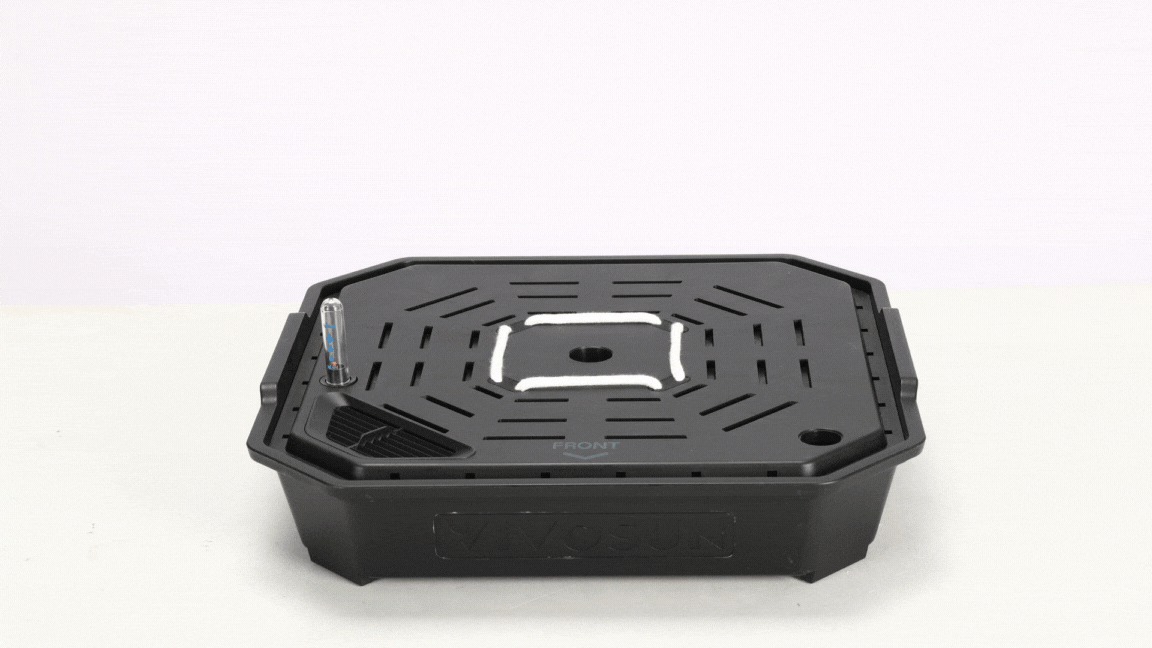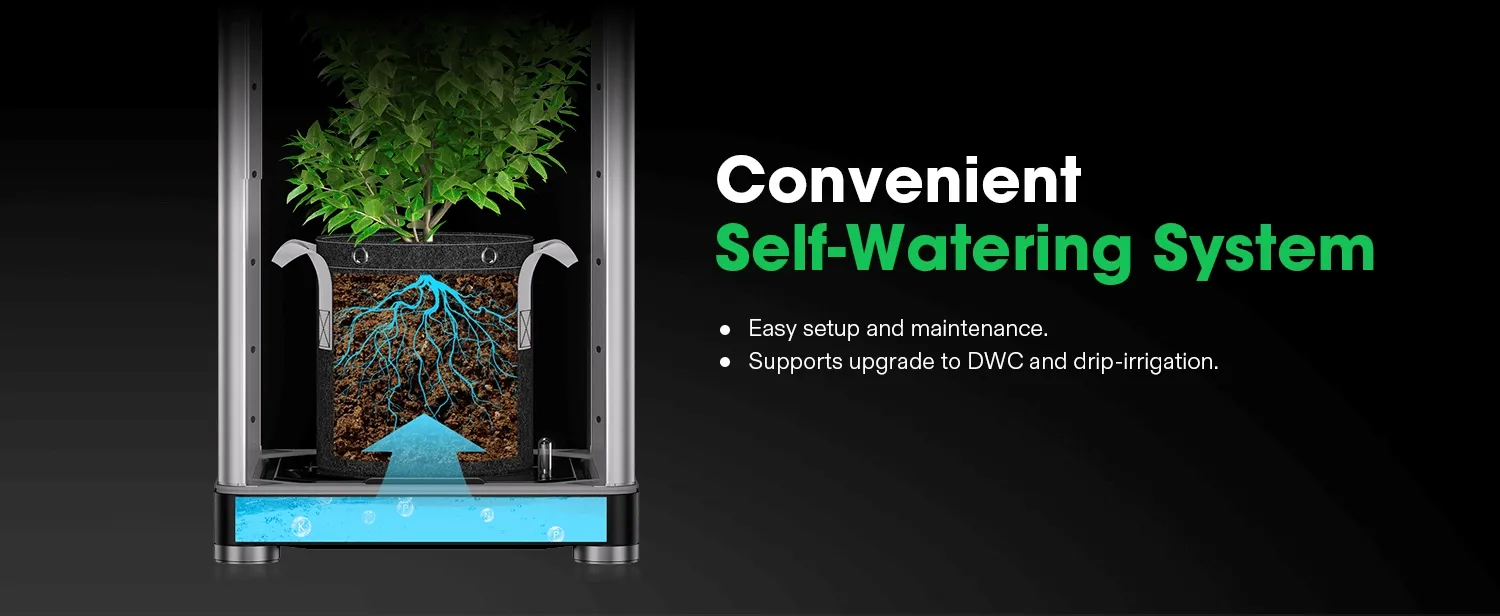Table of Contents
Understanding Self Watering Planters
What are Self Watering Planters?

How Do Self Watering Planters Work?
Top 3 Benefits of Self Watering Planters
1. Low Maintenance
The reservoir can sustain the plant for days or even weeks, depending on its size and the plant’s water requirements. Plus, with VGrow self watering pots, you’ll receive a water shortage alarm when the water level reaches the sensor.
2. Perfect for My Busy Lifestyle
3. Water Efficiency
3 Factors to Consider When Choosing the Right Self-Watering Planter
1. Size and Capacity
When selecting self-watering planters, consider the size and capacity that best suit your plants’ needs and the available space in your home. From small succulents to large houseplants, there’s a planter for every size.
2. Material Selection
Self-watering planters come in various materials, each with its unique characteristics. Choose durable materials like ceramic or plastic for longevity and functionality.
3. Design and Aesthetics
Choosing the Best Cultivation Method for Your Cannabis: My Personal Perspective
Selecting the right cultivation method for growing cannabis is crucial for achieving optimal results. As an avid cannabis grower, I’ve explored various techniques and learned firsthand the importance of matching the method to my lifestyle and growing knowledge. In this article, I’ll compare three popular methods: self-watering planters, deep water culture (DWC), and drip irrigation, to help you make an informed decision based on your preferences and expertise.
Self Watering Planters
If you’re like me, leading a busy lifestyle with limited time for gardening, self-watering planters offer convenience and simplicity. These systems provide a consistent water supply to the roots, requiring minimal maintenance and supervision.
Here’s why self-watering planters might be the right choice for you:
Ease of Use: Set up your self-watering planter and forget about it – almost. These systems are incredibly user-friendly and require little intervention once established.
Water Efficiency: Say goodbye to water wastage. Self-watering planters deliver water directly to the roots, promoting efficient nutrient uptake and reducing the risk of overwatering or underwatering.
Controlled Moisture: With self-watering planters, you’re in control of the moisture levels. Adjust as needed to ensure your cannabis plants receive the perfect amount of hydration, regardless of your hectic schedule.
Deep Water Culture (DWC)
For growers seeking rapid growth and maximum yield potential, deep water culture (DWC) is an excellent choice. This hydroponic method immerses cannabis roots directly in a nutrient-rich solution, fostering vigorous growth and robust plant development.
Here’s why DWC might be the right choice for you:
Rapid Growth: DWC systems are renowned for promoting accelerated vegetative growth and strong root development, thanks to the direct access to oxygen and nutrients.
Oxygenation: With DWC, your cannabis roots are constantly bathed in oxygenated water, reducing the risk of root rot and ensuring optimal nutrient absorption.
Precision Nutrition: Take full control of your cannabis’ diet with DWC. Tailor your nutrient solutions to meet the specific needs of your plants, resulting in healthier, more vibrant growth.
Drip Irrigation
Drip irrigation is another popular method used by cannabis growers to provide a consistent water supply to plants. This system delivers water directly to the root zone through a network of tubing and emitters.
Here’s why drip irrigation might be the right choice for you:
Efficient Water Distribution: Drip irrigation systems ensure precise water delivery to each plant, minimizing water wastage and promoting efficient water usage.
Customizable: With drip irrigation, you have the flexibility to adjust the water flow and frequency to meet the specific needs of your cannabis plants, allowing for optimal growth and development.
Low Maintenance: Once set up, drip irrigation systems require minimal maintenance, making them ideal for growers looking for a hands-off approach to watering.
Selecting the Suitable Cultivation Method
When considering options between self-watering planters, deep water culture, and drip irrigation, the following factors should be taken into account:
Lifestyle: If you lead a busy life with limited time for gardening, self-watering planters offer convenience and simplicity. However, if you’re enthusiastic about maximizing growth potential and have ample time to dedicate to your plants, both DWC and drip irrigation may be preferable. Moreover, if you seek to grow without soil, utilize coco coir, and maintain a clean environment, DWC would be the optimal choice.
Growing Knowledge: For novice growers seeking an easy-to-manage system, starting with self-watering planters is advisable. Conversely, if you possess experience and relish the challenge of mastering advanced cultivation techniques, both DWC and drip irrigation could prove to be the perfect match.
In conclusion, the optimal cultivation method for your cannabis plants hinges on your lifestyle, growing expertise, and personal preferences. By carefully considering these factors, you’ll be equipped to select the method that aligns best with your needs, facilitating success in your cannabis-growing endeavors.
Looking for Flexible Options? VGrow is the Answer!
As a user, I can confidently say that VGrow has transformed my cannabis-growing experience. This smart grow box offers unparalleled versatility, accommodating multiple irrigation methods like DWC, self-watering planters, and drip irrigation. With VGrow, I have the flexibility to tailor my growing technique to suit my needs and optimize plant growth.

FAQs
Yes, self-watering planters are suitable for a wide range of plants, including herbs, flowers, and vegetables. However, it’s essential to consider each plant’s specific water requirements.
The frequency of refilling depends on various factors, such as the planter’s size, the plant’s water needs, and environmental conditions. Generally, self-watering planters may require refilling every few days to weeks.
DIY self-watering planters can be just as effective as store-bought ones if properly constructed and maintained. However, it’s essential to follow instructions carefully and ensure adequate moisture distribution to the plants’ roots.
Yes, self-watering planters help prevent overwatering by delivering water directly to the roots as needed. The reservoir ensures a consistent supply of moisture without the risk of waterlogging the soil.
While self-watering planters are primarily designed for indoor use, some models are suitable for outdoor environments. However, it’s crucial to choose durable materials that can withstand outdoor conditions and provide adequate drainage.
Conclusion
In conclusion, the rising trend of indoor gardening has sparked interest among enthusiasts seeking convenient and efficient ways to nurture their plants. Self-watering planters emerge as a revolutionary solution, offering hassle-free plant care with minimal maintenance. With their built-in reservoirs and efficient water delivery systems, self-watering planters ensure optimal hydration levels, making them ideal for busy individuals and frequent travelers. Additionally, exploring cultivation methods such as deep water culture and drip irrigation provides valuable insights into maximizing growth potential and achieving robust plant development. Whether you’re a novice grower or an experienced enthusiast, selecting the right cultivation method depends on your lifestyle, growing knowledge, and personal preferences. By considering these factors and exploring innovative solutions like VGrow, you can elevate your indoor gardening experience to new heights.







